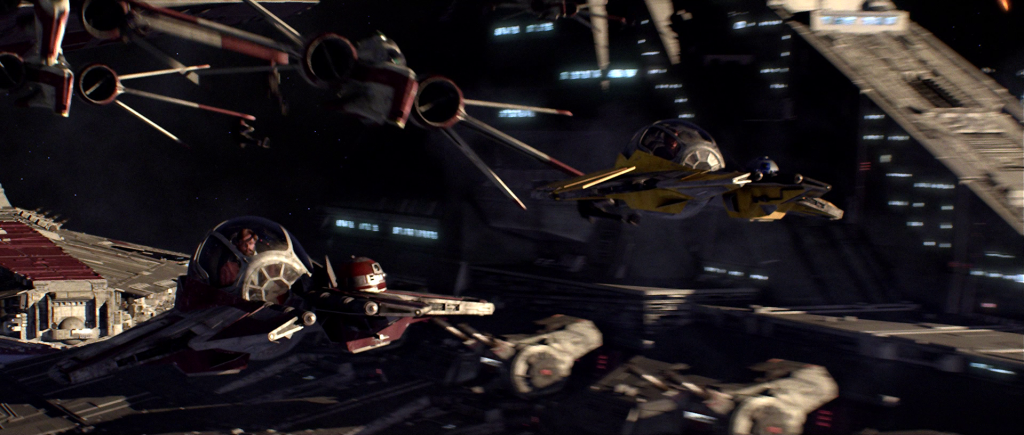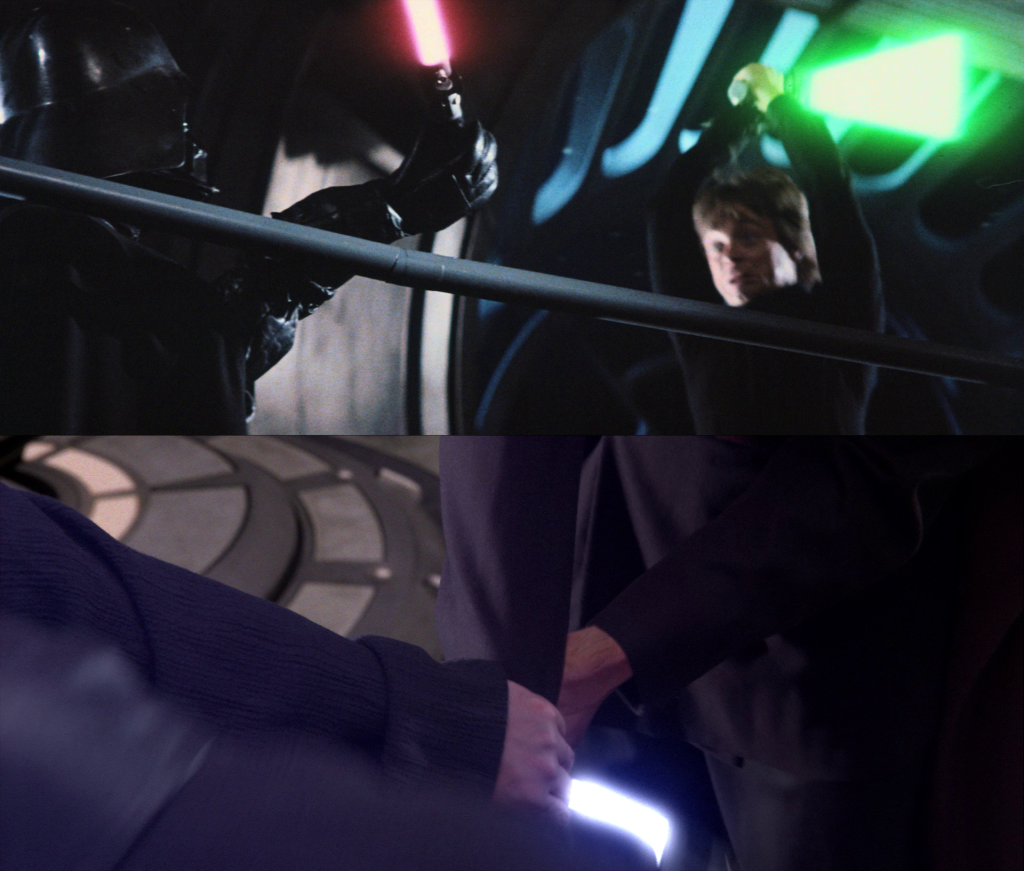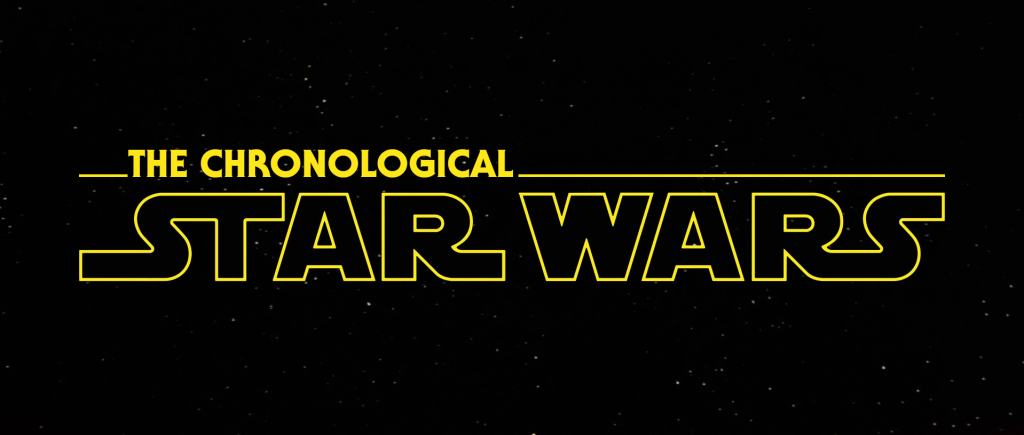For the most part I’ve made my peace with the Star Wars prequels. None of them are good, exactly, but Attack of the Clones deals with some interesting ideas and compelling themes hampered by shoddy execution; and The Phantom Menace is far better than its reputation would suggest thanks to imaginative visuals and a raw feeling of exuberance that helps carry its off-tempo story structure. These movies are obviously, deeply flawed, but amid those failings there are bits and pieces worth latching on to.
That’s why it’s so frustrating that basically nothing in Revenge of the Sith works.
As far as it’s possible to have an unpopular opinion under the enormously basic umbrella of thinking the Star Wars prequels aren’t very good, picking Revenge of the Sith as the worst one is probably right up there. On some level, I get why that’s the case. On a purely textural level, it bears the closest resemblance to the original films. It doesn’t spend a ton of time on political conspiracies or ineffectual romances; it’s largely devoid of the kind of silly, kid-focussed humor that fans bristled against in the previous films; and in its place, the movie opens with a huge space dogfight, there are wookiees, and stormtroopers, and Darth Vader himself. It’s almost as if, after taking a beating from the fans on the previous two films, Lucas threw up his hands in surrender and spent 140 minutes giving fans exactly what they asked for. The problem is that all of the attempts at fan service feel utterly hollow and the story the movie needs to tell falls flat at every turn.
The Star Wars prequels had two big things they needed to accomplish: tell the story of Anakin’s fall to the dark side, and demonstrate how the Republic of old collapsed, giving way to the tyranny of the Galactic Empire. Structurally, the first two movies spent the bulk of their time laying groundwork, putting all the dominos in place and setting Episode III up to be the film where everything the series has been building towards finally comes to pass. For any of the previous films’ weaknesses, they did that job reasonably well. Episodes I and II show us a Republic bowing under the weight of tedious bureaucracy and corporate corruption with a dark conspiracy in place to take advantage of those failings in order to seize unprecedented political power. They also show us a young man with a troubled background welcomed into a religious institution that is too caught up in its own dogma to meet the needs of someone who is clearly struggling. It wasn’t pretty, but the table was set, and all Revenge of the Sith had to do was not screw it up.

The film begins with what is effectively the final major battle of the Clone Wars. In a final, desperate move, the Separatist army invades Coruscant and captures the Supreme Chancellor, and we come into the story as Anakin and Obi-Wan are tasked with carrying out his rescue. This is meant to serve as the high point in the story, a glimpse at these two Jedi Knights working well, not just as a team, but as good friends. The problem is that a lot of the action in this sequence is tepid and the banter traded back and forth lands with a thud. It’s an attempt to evoke the feeling of the original Star Wars – so much so that John Williams even uses a bit of the “Rebel Fanfare” in the score for this sequence – but it largely fails in that goal. The action, the writing, the performances and attempts at comedy, all of it feels stiff and forced in a way that the original films don’t. The use of the signature leitmotif of the Rebel Alliance, for the first and only time in the prequel trilogy, feels like a cheat; it’s invoking a theme that doesn’t belong in order to trigger nostalgia and instill an emotion that the film otherwise is unable to accomplish.
Worse than that, though, is when the Jedi finally reach the Chancellor and Anakin is faced with the choice of taking the villainous Count Dooku prisoner or killing him on the spot. He chooses the latter, spurred on by the recommendation of Palpatine, but the moment doesn’t resonate with any real weight. It’s a moment that’s supposed to reinforce, right at the top of the film, the emotional turmoil Anakin is dealing with, but it comes across as distinctly unemotional. Anakin barely wrestles with the weight of the choice, nor does he appear to be consumed by a thirst for vengeance. Palpatine describes Anakin’s supposed reaction after the fact, but none of that comes through in the performance or in the staging of the scene. For all my critiques of Anakin’s slaughter of the Tuskin Raiders in Attack of the Clones, by comparison that scene is a far better window into Anakin’s pain than the execution of Dooku.
The maddening irony here is that in my article on Clones, I used Luke’s duel with Vader in Return of the Jedi as a point of comparison showing how this emotion could be conveyed with real resonance, and in Revenge of the Sith, Lucas copies that scene almost shot for shot. Dooku drops a platform on top of Obi-Wan and Anakin responds with a flurry of blows shot in medium. There’s a wide shot that pans left as Anakin pushes Dooku backwards across the room with his attacks. Finally, Anakin incapacitates Dooku, cutting off his hands, as Palpatine goads the young Jedi into killing his apprentice. The problem is that Lucas does a worse job of it in 2005 than Richard Marquand did in ‘83. Where there’s a messy unpredictability to Luke’s attacks in Jedi, all the strikes in Sith feel choreographed and calculated. The action pauses so Dooku can talk about Anakin’s anger rather than allowing us to simply feel it. When we actually see Dooku disarmed, it’s shot and cut together in bizarre way that makes it difficult to track what’s happening; the lightsaber comes from below and the hands obscured, so it’s not clear what we’re seeing until it’s already happened. The action of the opening sequence feels phoned in and uninspired, and the big emotional payoff feels muted and unearned.

This carries through pretty much the entire rest of the film; alternating between fan service that falls flat and important story moments that fall flatter. It’s not that the ideas presented are bad, it’s just that the movie can’t manage to sell them. Anakin panicking over visions of his dying wife and being unable to find support in the Jedi is good drama, so too is Palpatine, the secret Sith Lord, being the only one to offer compassion and guidance, but it never really plays. We see Palpatine pulling the strings, but we don’t ever get to feel the earnestness of that relationship. We see Anakin’s frustrations with the Jedi Council, particularly Mace Windu, but we don’t see how that colors his feelings of the Jedi as a whole. In some small way, watching Revenge of the Sith immediately following The Clone Wars helps fill in some of these gaps. We get to better understand Anakin’s turmoil after seeing the Jedi fail his apprentice, see his simultaneous affection for Obi-Wan and frustration with the Council, and feel the warmth he feels towards Palpatine as a mentor, but that only counts for so much. A series that ran almost ten years later can’t retroactively save a movie that didn’t do the work on its own, and Revenge of the Sith doesn’t do the work.
This all comes to a head with the event that the whole prequel series has built towards: Anakin’s turn to the dark side. I won’t dwell on the direction of the initial fight between Palpatine and the members of the Jedi Council who come to arrest him (suffice it to say, it’s catastrophically bad) because it’s the moment when Anakin comes in that really matters. Anakin is conflicted. He knows Palpatine is a Sith Lord. He also has years of friendship with the Chancellor (or so we’re told) and believes that he’s the only one who can help save Padmé’s life. When he arrives on the scene, Palpatine is in a vulnerable position at the mercy of Mace Windu. So far so good, plenty of room for Anakin to leap to conclusions about the situation. Each party presents their argument, Palpatine says the Jedi are staging a coup, Windu says the Sith need to be stopped. And then Sheev growls, “you will die!” and zaps Mace with lightning. Oops! If the goal is to put Anakin is a position where he doesn’t know who to trust, probably safe to go with the guy who doesn’t have electricity shooting out of his finger tips.
Finally, after being horribly scarred by his own lightning (again, which Anakin definitely saw happen), Sidious relents, begging for mercy and asking Anakin for help. If this was the point where Anakin entered, we might have something here. Palaptine seemingly defeated and pathetic, Mace Windu, filled with righteous fury, ready to execute him. That’s a tougher call to make, not having the context of the whole lightning bit. But still, Anakin tries to convince the Jedi Master to take the Chancellor into custody, and when he won’t, he cuts off Windu’s arm, leaving him defenseless to another bout of lightning. Oops!

But even all that isn’t the worst of it. No, the worst of it is, after contributing to the murder of one Jedi, Anakin feels so guilty that he decides it’s time to butcher some children. A switch flips inside of Anakin’s psyche, but the movie doesn’t do the work to get us there with him. In the space of literally three lines, Anakin goes from exclaiming in anguish, “what have I done?” to pledging himself to the dark side and agreeing to lead a death squad into the Jedi Temple. That’s a big leap to make, and the movie does a poor job of making that leap make sense.
I would not be the first person to make the connection of Anakin Skywalker as a school shooter, but it is an apt comparison. Coming just a few years after the Columbine High School massacre, it’s easy to imagine that playing into how George Lucas wrote and directed Anakin’s inevitable turn. The problem, though, is that a lot of the popular narrative surrounding Columbine is rooted in bad information and out-and-out lies. We have this idea of troubled, frustrated young men who were bullied until they could no longer stand it and snapped, but according to people closest to the situation – chief among them the FBI investigators and Dylan Klebold’s own mother – that’s not exactly what happened. Eric Harris wasn’t bullied, he was a bully. He was sadistic and wanted to hurt others, and he roped in the depressed and suicidal Klebold to help carry out his plans. They both did the same horrible thing, but they did so coming from very different places. Revenge of the Sith tries to sell us on Anakin’s frustration and fear as the root of his darkness, but what it really needed to show us was someone so broken down, so desperate, that they were willing to commit atrocities just to find some semblance of purpose. Sidious plays to Anakin’s frustration with the Jedi, selling him on a vast conspiracy to seize power, when instead he should have played to the young Jedi’s self-loathing and doubt, telling him he’d wandered too far down the dark path and there was no way to return.
Once again, this fatal mistake has ripples through the rest of the film, culminating in the final confrontation between master and apprentice. The duel with Anakin and Obi-Wan, on a purely technical level, is by far the best action setpiece in the movie. It moves and progresses and develops in the way a good action sequence should, and it’s no wonder it does given that Lucas brought Steven Spielberg in to consult on the early planning and previsualization of that sequence. The problem is, for all its technical successes, it still utterly fails from an emotional standpoint. These are two friends wrestling with feelings of loyalty and betrayal – one desperately trying to save the other’s soul and the other consumed with anger, confusion, and sadness – and none of that comes through in the fight. The only point it comes close to working is at the very end, when Obi-Wan delivers a plea to Anakin filled with these conflicting emotions, but unfortunately he’s playing against a shrieking, yellow-eyed quadriplegic, slowly sinking into a pool of lava. Once again, I don’t want to lay too much blame at Hayden Christiansen’s feet considering he was working with a filmmaker who is famously not great at directing actors, but where Ewan McGreggor brings the sort of nuance this scene demands, Christiansen simply doesn’t.

Ultimately that’s what this all boils down to. The Star Wars prequels have their ups and their downs and we can debate the ratio thereof for decades on end, but Revenge of the Sith was the moment of truth. It’s where everything these movies had been building towards had to come together and work, and it just completely whiffs it at every turn. The whole movie feels tired; whatever spark of excitement Lucas had in coming back to this world with The Phantom Menace feels well and truly gone by this point. Even the way he talks about it in behind the scenes material makes it sound like an obligation rather than a passion, there’s no talk about creativity or innovation the way there was on earlier movies, it’s all fan expectations and filling in the remaining gaps in the narrative. It’s just an endless bummer to sit through.
I wish I had a more positive take on this movie. I’ve come around to almost liking The Phantom Menace, and there are even things I enjoy about Attack of the Clones. I’m hard pressed to find anything I sincerely like in Revenge of the Sith. For all of The Clone Wars’s inconsistencies, I’m happy at least that it allowed Lucas one final opportunity to have fun in the sandbox he created – to chase his own interests and expand the story into strange and exciting new places that feel so deeply personal to this wonderfully idiosyncratic filmmaker. Making my peace with the prequels has also meant making my peace with Lucas. Like so many others, I began to resent him for the endless revisions of the original trilogy and the disappointment of the prequels, but with the clarity of hindsight it’s clear that Lucas himself was trapped under the weight of his own legacy. I can’t say for sure that the negative response to the previous two films changed Lucas’s approach going into Revenge of the Sith, but boy does it sure feel like it, and it ends up just being a huge bummer. Whatever you can say about Lucas, he’s not at his best when just asked to play the hits. He’s a deeply weird, deeply interesting filmmaker, and I’m glad his time with Star Wars didn’t end with him doing covers of his own most famous work.
Leading up to the release of Star Wars: The Rise of Skywalker, I am endeavoring to watch every canonical Star Wars movie and TV show in the in-universe chronological order. Follow along with…


2 thoughts on “REVENGE OF THE SITH and the Terrible Burden of Expectations”